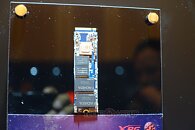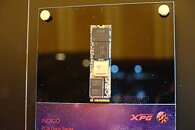Tuesday, January 7th 2020

ADATA Unveils a Trio of PCIe Gen 4 M.2 SSDs That Aren't Phison E16 Fare
Phison was first to market with a client-segment PCI-Express gen 4.0 NVMe SSD controller, and as a result, the first wave of gen 4.0 M.2 SSDs have been dominated by the E16-series controller. At CES 2020, we got to see some of the first drives based on PCIe gen 4.0 controllers from other manufacturers such as Silicon Motion and InnoGrit, thanks to ADATA. With begin with the company's latest-generation XPG SAGE M.2 NVMe SSDs with PCI-Express 4.0 x4 interface, which come in capacities of up to 4 TB, and which are powered by InnoGrit "Rainier" IG5236 controller, belting out sequential transfer speeds of up to 7,000 MB/s reads, with up to 6,100 MB/s writes, and up to 1 million IOPS 4K random access. The drive supports the latest NVMe 1.4 protocol.
Next up is the XPG Indigo, another M.2 NVMe PCI-Express 4.0 x4 drive positioned a notch below the XPG Sage. This one uses Silicon Motion's fastest PCIe gen 4.0 client-segment controller, the SM2264. With capacities of up to 4 TB, the drive offers up to 7,000 MB/s sequential reads, up to 6,000 MB/s sequential writes, and up to 700,000 IOPS 4K random-access performance. Lastly there's the XPG Pearl, a high cost-performance model powered by the mid-range SM2267 controller which has a PCIe gen 4.0 x4 interface and DRAM cache, comes in capacities of up to 4 TB, but offers a slightly tamed performance that's comparable to E16-powered drives: up to 4,000 MB/s sequential reads, up to 3,000 MB/s sequential writes, and up to 400,000 IOPS 4K random access. The new-gen XPG Sage, XPG Indigo, and XPG Pearl will release later this year.
Next up is the XPG Indigo, another M.2 NVMe PCI-Express 4.0 x4 drive positioned a notch below the XPG Sage. This one uses Silicon Motion's fastest PCIe gen 4.0 client-segment controller, the SM2264. With capacities of up to 4 TB, the drive offers up to 7,000 MB/s sequential reads, up to 6,000 MB/s sequential writes, and up to 700,000 IOPS 4K random-access performance. Lastly there's the XPG Pearl, a high cost-performance model powered by the mid-range SM2267 controller which has a PCIe gen 4.0 x4 interface and DRAM cache, comes in capacities of up to 4 TB, but offers a slightly tamed performance that's comparable to E16-powered drives: up to 4,000 MB/s sequential reads, up to 3,000 MB/s sequential writes, and up to 400,000 IOPS 4K random access. The new-gen XPG Sage, XPG Indigo, and XPG Pearl will release later this year.



13 Comments on ADATA Unveils a Trio of PCIe Gen 4 M.2 SSDs That Aren't Phison E16 Fare
Obviously there are some IOPS numbers, but they don't always translate directly to random performance figures.
Also, how much?
Nice to see 4TB capacities though, although I guess they're going to be somewhat out of reach for now.
I hope they plan to put a heatsink on this ADATA drive it will need one.
Keep in mind that the controller you have from Phison is a bit of a hack job, as they pretty much just shoehorned in a PCIe 4.0 bus into an existing design on a less than optimal production node and that's part of the reason as to why it's getting so hot.I guess TPU hasn't gotten around to seeing their new drive yet. Comparatively unimpressive.
www.anandtech.com/show/15352/ces-2020-samsung-980-pro-pcie-40-ssd-makes-an-appearance
All of the bare drives will throttled when pushed.
We will have to wait for reviews once this is out.
The drive temps on the corsair drive isn't bad when in a case with good air flow.
I'm using mine in the M2 slot directly under the cpu.
And temps aren't bad I also have two Samsung 860Evo's on the backside of the motherboard with good temps.
A lot of heatsinks on M.2 drives does little to nothing, with the exception of the Phison E16 controller which runs hot as hades.
And no, not all bare drives throttle when pushed, please don't make things up. It all comes down to the controller. If you'd said most high-end M.2 SSD's throttle when pushed, I would've agreed. Obviously, if it's in a bad spot in your case, like under a graphics card, it's going to thermal throttle, as there's not much airflow going on.
Case in point, WD Black, no thermal throttling.
www.techpowerup.com/review/western-digital-wd-black-2018-nvme-500-gb/7.html
Obviously we do have to wait for reviews to see if these new drives deliver, but one shouldn't jump to conclusions.
Case in point, my first Viper VPN100 had a poorly mounted heatsink, it didn't even touch the controller, so the drive would thermal throttle after a minute of benchmarking.
At least they swapped it out for a new drive with a properly installed heatsink within a couple of days.
One drive isn't really enough prove or disapprove the point too small a sample of whats on the market.
I have 5 8200 Pros, where one 2 TB model is 4 months old, one 1 TB nearly a year old and two 512 GBs where one is 8 months old and I forgot how old the other one is) and they haven't failed me yet. The 1 TB is the one taking a beating because I have compute/CUDA stuff running off it.You may be confusing that 4 TB NVMe Rocket which is still PCIe Gen3 x4. Their Gen4 x4 M.2s are still up to 2 TB. Amazon has them for better prices at the moment.